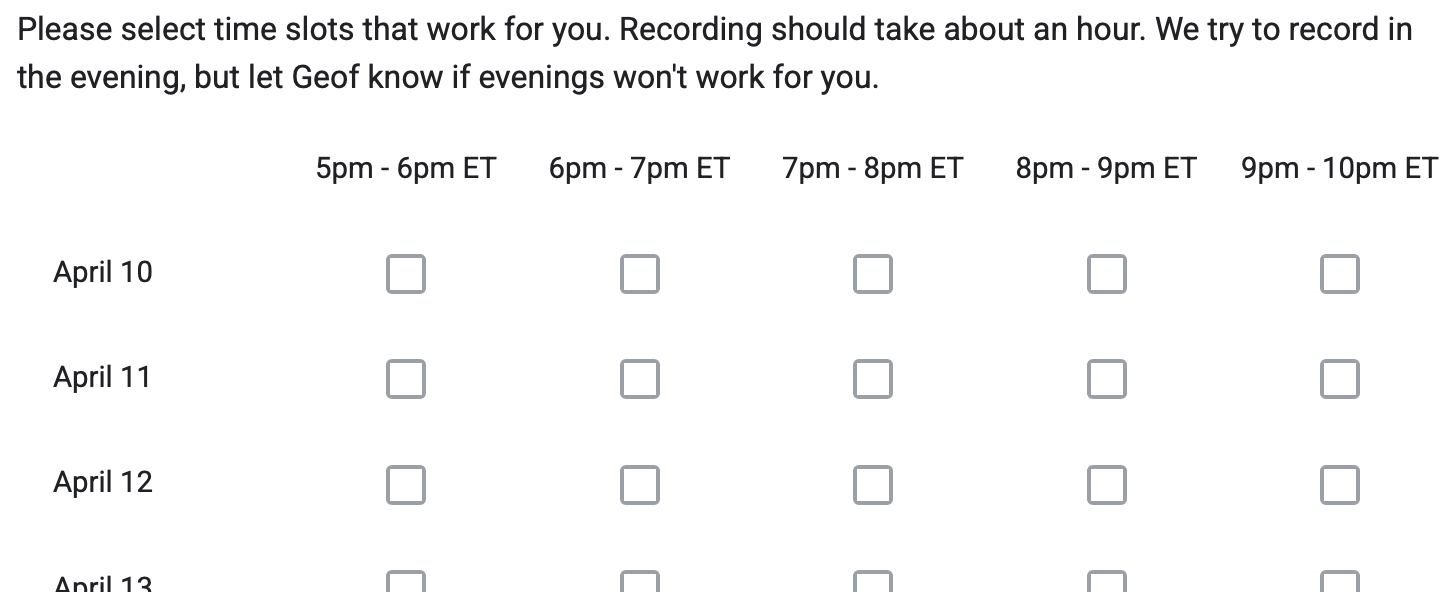I get this question a lot: I want to start a podcast, but how do I get started?
It’s an important question, and I love sharing the lessons I’ve learned from my experience with podcasting. To make this info more easily accessible and widely available, in this post I will share some reflections and lessons learned from doing the Planet Bio podcast, as well as resources for getting started.
Before digging in, it’s important to note that this post is anchored on experiences with the Planet Bio podcast, which is a side-project done entirely for fun and to support those interested in startups. The podcast doesn’t make money, and we haven’t tried to get the largest audience possible. The team hasn’t invested in sophisticated podcasting software or tools. In the end though, the podcast is entirely fun and still impactful, so let’s dig in!
Getting Started - The Origin Story
The hardest part of the podcasting process is getting started. This is how the Planet Bio team got going:
A couple of years ago Hamdi, Alexa, and myself started hosting live virtual office hours for startup founders on LinkedIn. Our goal was to share entrepreneurial experiences and insights with founders, people at startups, or anyone generally interested in startups. It was a really fun time where we would go live, people would login to ask questions, and we would have great conversations. Topics would include fundraising, hiring, developing partnerships with large companies, and many others.
But there was a problem with our LinkedIn format.
Our forum was only live, so the only way to get the information was to login at the specific time. This was an issue for anyone who was busy and still wanted to hear the conversation. The obvious solution was to record and share the sessions, but recording on LinkedIn live was surprisingly difficult and we weren’t sure about the best way to host and post those recordings. After some thought (as well as trying some platforms like ClubHouse), we decided a basic podcast format would be a great solution for recording, hosting, and sharing. So we went to work figuring it out.
Organizing & Planning
Once a team has some momentum for getting started, it’s time to organize and plan some episodes. The first step here is to align on the format for your podcast. At Planet Bio, we have tried office hours (allowing people to log in and ask us questions), special guests (a planned interview where a live audience could ask questions), and current events/trends. All of these can be insightful, but require different levels of planning.
The special guest format requires to most work, because it needs scheduling, planning questions, research, and then getting approvals for the final product (we always run the final product by the guest before posting). We use Google Sheets to track dates, guests, topics, and status for each episode. Our general step-by-step workflow is:
[Not Booked] -> [Pending Confirmation] -> [Booked] -> [Recorded] -> [Edited] -> [Scheduled For Posting] -> [Published]
One way to easily schedule dates is to use a Google Form with a grid survey question. You can see in the example below for how we ask guests to pick times on dates using a survey grid:
Our other formats are a bit easier to plan. Office hours involve going live and inviting guests to join us (we promote the link on LinkedIn so that people knew when to join). We also really enjoy the “current trends” format where the team would get together to discuss news, industry trends, and what they are reading. The “current trends” format really only requires the team to be online together to talk.
Hosting The Podcast
Once the episodes are planned and guests are booked, it’s time to setup the actual podcast. We ended up using Spotify for Creators. It’s an easy, basic, and free platform that will allow you to cross-post to other major platforms like Apple Podcasts. Once you get setup, your podcast will automatically show up on the hosting platforms you choose, and you can share episodes through social media such as LinkedIn or Bluesky.
Recording
Recording was probably the trickiest component for the team to figure out. In the early days, we tried recording through Zoom and Microsoft Teams, but the resulting audio was on a single channel that made editing really difficult (you will want to split the audio by who is speaking). We also tried recording the laptop audio on our phones and then splicing it together (yes, we really did try that) but the quality wasn’t great and syncing the recordings was sometimes challenging.
Finally we landed on Discord. It’s an easy platform to setup a group for recording, and you can even easily invite a live audience to join. We use the channel recorder Craig to record our live streaming conversation, and Craig will automatically split the recordings by speaker. It’s a surprisingly robust and useful resource.
Editing & Posting
The editing part of the production process can be intimidating. There are a lot of tools and they can come with a bit of a learning curve. Some of them have useful functionality such as detecting and eliminating “umm” and other filler, but they can also cost a bit of money. Audacity can be a free option, but we ended up going with GarageBand, which is a standard Apple tool available on Macs. It took a bit of learning and practice, but it’s ultimately a great tool for easily editing the audio files provided by Craig.
Once an episode is edited, you can export for posting through Spotify. It’s as easy as that! Just don’t forget to run it by the team and any guests for their approval before posting.
After the episode goes live, you can also share through your network, including LinkedIn, Bluesky, email, or whatever works best for you. Again, this step is pretty easy.
Conclusions
So there we have it. The resources and lessons learned from the Planet Bio podcast, so that you can get up and running with your own fun podcast! Ultimately the hardest part is just getting started, and then it’s a lot smoother once it’s running. The only wrinkle in the process is finding the time and scheduling. Like any fun side project, it can end up on the back burner when things get busy, but ultimately that’s fine because the whole goal is to have fun and do what you can!
As always, thanks for reading!




